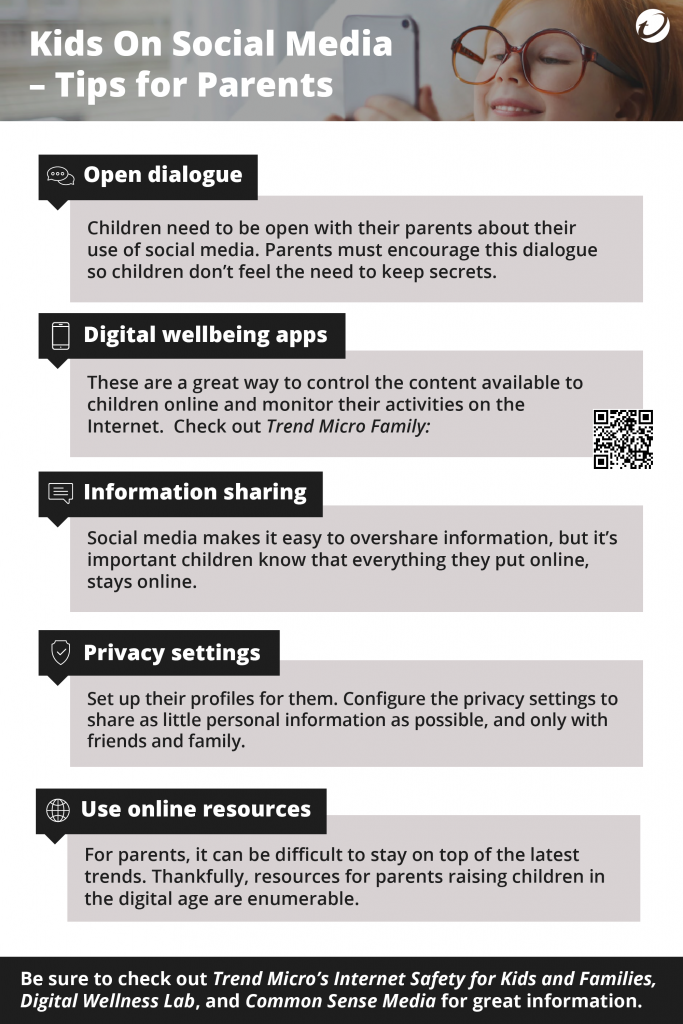All the most popular social networks — Facebook, Twitter, Instagram, TikTok, and more — only allow users aged 13 and over. The Children’s Online Privacy Protection Act (COPPA) is in place to enforce this. However, a report found that 42% of children aged between 5 and 11 years old use social media, with 59% of 11-year-olds, and a whopping 74% of 12-year-olds having at least one social media profile.
They’re using it more now, too. The pandemic saw an overall increase in the amount of time children spend online. However, according to a study conducted by Rutgers University, it was skyrocketing even pre-pandemic.
Trend Micro — creating a safer cyberspace
Trend Micro Family for Kids is a real-time image filtering application. Containing built-in features to ensure children’s digital wellbeing and leveraging AI technology, the free extension for Google Chrome and Microsoft Edge is an indispensable safeguard.
The app automatically filters explicit graphics relating to:
- Pornography
- Alcohol and drugs
- Gambling
- Racism
- Violence, and lots more
Use Trend Micro Family for Parents to set content restrictions, understand your child’s digital footprint, and ward off potential cyber threats: Android | iOS
Understanding the risks
For parents of young children, it’s important to get a clear understanding of the potential dangers they face when using social media.
Cyberbullying
Cyberbullying is bullying that occurs through digital devices, and a significant portion of it happens through social media. Similar to real-world bullying, cyberbullying can have severe, long-lasting effects on the victims.
70% of young people will experience some form of cyberbullying before turning 18. The most common methods of cyberbullying are mean comments (22.5%), spreading online rumors (20.1%), and making sexual remarks (12.1%).
A study found that children and young people under 25 who are victims of cyberbullying are twice as likely to self-harm and attempt suicide.
Offensive and age-inappropriate content
There is lots of content online that is not suitable for children. Exposure to it can have a profoundly negative effect on a child. This includes sexually explicit graphics, depictions of violence or cruelty towards humans or animals, materials containing vulgar language, content promoting racism, terrorism, eating disorders, and much more.
It’s very important to mention the fact that online content is not always as it may seem. Back in 2017, there was a huge controversy (dubbed Elsagate after the Disney Princess) relating to over 150,000 videos (since removed) on YouTube Kids that featured grossly inappropriate content relating to drugs, violence, alcohol, and sex.
Online predators
There are many predators out there who use social media sites as a platform for grooming children. They often send inappropriate content to their victims. For many of these predators, the goal is to build up enough trust that the victim feels comfortable meeting in person.
Worryingly, with children spending more time online now, there has been a rise in online predators exploiting children. Recently, the perpetrators have been contacting minors through websites designed for children seeking help with their homework. From there, they will then take the conversation to a social media app.
Scams
It is children’s natural naivety and curiosity that make them perfect targets for social media scams. The scams are often highly sophisticated, so it is crucial that children are taught to remain constantly vigilant online. Examples of such scams include survey scams, fake lottery scams, and phishing scams. Phishing scams are particularly dangerous because scammers will often commit identity theft using the victim’s stolen personal information.
The financial scams taking place on social media are perhaps the current biggest cyber threat to children. The scammers are immensely cunning in their deceptions. They convincingly pose as friends or family members in an effort to dupe kids into transferring money.
Tips for parents
It’s by no means an exhaustive list, but here are some of our top tips for parents with kids who use social media:
- Open dialogue
Above all else, it’s important that children are open to their parents about their use of social media. Parents must encourage this open dialogue so children don’t feel the need to keep secrets.
- Digital wellbeing apps
These are a great way to control the content available to children online and monitor their activities on the Internet.
Download Trend Micro Family here.
- Information sharing
Social media makes it easy to overshare information, but it’s important children know that everything they put online, stays online.
- Privacy settings
Ideally, parents will help their children create their social media profiles. As soon as the profile is set up, the privacy settings should be configured so as little personal information is shared as possible, and only with friends and family.
- Use online resources
For parents, it can be difficult to stay on top of the latest trends. Thankfully, resources for parents raising children in the digital age are enumerable. Some great sites to check out include Trend Micro’s Internet Safety for Kids and Families, Digital Wellness Lab, and Common Sense Media.

Their safety is our priority
Whether they get started early or wait until they’re 13, children will inevitably want to explore social media. Oftentimes it’s peer pressure that’s the impetus for them wanting to set up their first profile. It’s understandable, though. If all their friends are using social media, it’s natural that they wouldn’t want to miss out. We just need to do everything in our power to keep them safe!


